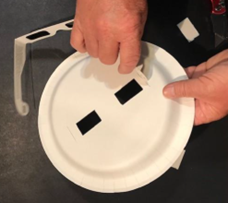The next solar eclipse will be visible across North America on Monday, April 8, 2024.
Solar eclipses occur when the moon passes between the sun and the Earth, blocking sunlight and casting a shadow on our planet. There will be a 115-mile-wide path stretching from Texas to Maine with a total eclipse, while the rest of the continental United States will experience a partial eclipse.
Like many families, you may be excited to see a solar eclipse with your children. Here are some tips to help you experience this rare event safely.
Viewing the eclipse while protecting your eyes
There are a few ways to view a solar eclipse without risking permanent vision problems from damage to the delicate tissues of the eye, including the
retina and the cornea.
Remember that it is never safe to look directly at the sun, even during a solar eclipse. Only during "totality," when day suddenly becomes night with
no visible light from the sun for a few minutes, is it briefly safe to look at the sun completely blocked by the moon. Still, use caution even then.

Image credit: NASA
Otherwise, a solar eclipse should only be viewed with
eclipse glasses or
binoculars that have a solar filter meeting the
ISO 12312-2 international standard.
Your eclipse glasses should have the
ISO number and logo, and the manufacturer's name. Also, check your eclipse glasses for any damage.
Be sure that you and your children are wearing the solar filter before looking towards the sun. Then, continue to wear it until you look away from the sun.
Younger kids & those with developmental disabilities
For younger children, consider making the eclipse glasses more secure by crafting a wider shield from paper plates. For more fun, your kids can even decorate the shield (see this hands-on activity suggested by NASA).
You can also help prepare children with autism or other developmental disabilities for the eclipse experience with a social story like
this one.
Can we use regular sunglasses to view the eclipse?
It is NOT safe to use sunglasses (even very dark ones with UV protection), polarizing filters, X-ray film, photographic neutral-density filters, or any other filters that are not specifically designed for viewing a solar eclipse. These do not adequately block dangerous UV rays from the sun.
It is also not safe to use a telescope, binoculars, or a camera viewfinder without a solar filter, even if you are wearing eclipse glasses. This is because the focused rays of sunlight can damage the filter and then damage your eyes. Using your smartphone camera also risks accidentally looking at the sun while you position the camera.
Another way to experience a solar eclipse is indirectly using a
pinhole projector. This can be as simple as a small pinhole in an index card to project the image of the sun onto any surface with your back to the sun. DO NOT look at the sun through the pinhole.
NASA will live stream the solar eclipse, so that a cloudy sky will not foil your plans to view it. You can also watch the live stream to see the total eclipse if you are not in the path of totality. A "trailer" for the solar eclipse can be viewed here:
https://svs.gsfc.nasa.gov/14520/.
It will be exciting for most of North America to experience the solar eclipse, whether it is total or partial. Take these precautions to view it safely to avoid severe damage to your and your children's eyes.
More information